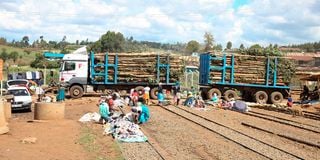How commercial forestry can help sustainable construction and unlock green financing

A truck loaded with timber on the Elburgon-Mariashoni road in Nakuru County on Wednesday. Kenyans can make good use of fast-growing commercial forestry species.
Like many countries, Kenya faces increasing pressure to adopt sustainable construction practices.
As the Kenya Green Building Society, we hope to encourage and champion the push for commercial forestry as a way of helping the country utilise its natural resources and adopt sustainable construction.
Kenya is also facing challenges in meeting the demand for sustainable construction materials.
With the country’s population projected to hit 60 million by 2030, the demand for housing and infrastructure will rise.
There will be an increased need for sustainable building materials and eco-friendly practices that will contribute to Kenya’s efforts in reducing carbon emissions, especially as we transition and mainstream the green agenda.
It, therefore, means Kenya needs housing to cater to its growing population. This, however, should be in an intentional way that balances people and the planet.
In this regard, a key benefit of commercial forestry is the ability to provide a sustainable and renewable source of timber.
Commercial forestry
By promoting commercial forestry, Kenya can ensure timber harvesting is sustainable, preventing deforestation and ensuring the woodland ecosystem remains intact.
Sustainable construction involves building structures and infrastructure that minimise their impact on the environment and promote long-term sustainability.
This involves using renewable or recyclable materials, reducing waste and minimising energy consumption.
Commercial forestry can play a huge role in supporting this agenda.
First, it can provide a sustainable source of building materials.
One of the primary benefits of commercial forestry is its ability to provide a reliable source of sustainable, locally-sourced timber for building and construction. This reduces dependence on imports.
The country sources timber from Europe and South Africa.
Commercial forestry can promote sustainable land use practices that are critical to the country’s socio-economic well-being.
Secondly, commercial forestry can help reduce deforestation and habitat loss.
These will go a long way in assisting Kenya, whose forest cover is just six per cent.
Third, the use of wood in construction can create a healthy indoor environment for occupants as timber has natural abilities to regulate humidity and air quality, which would work well to counter the effects of pollution, especially in urban and peri-urban centres.
Sustainable finance
Fourth, by using materials sourced for commercial forestry to directly support the affordable housing agenda, we will have alternative and sustainable building materials that can support the government in meeting the 250,000 annual demand for housing per year.
We can do so with a sustainable material that allows new affordable housing projects to be green certified.
The above would mean that we would help Kenya mitigate carbon dioxide emissions in the biggest emitting industry – the built environment – preserve our natural resources, create revenue in an industry that supports approximately 10-15 per cent of Kenya’s GDP, assist forestry and real estate sectors in job creation, meet the demand for affordable housing, build sustainably and potentially attract sustainable financing for the construction industry as well as the forestry industry to support Kenya, in being the climate champion in Africa.
Nasra Nanda, CEO Kenya Green Building Society




